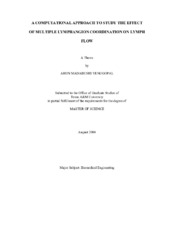| dc.description.abstract | The lymphatic system acts to return fluid from the interstitial space back into the blood circulation. In normal conditions, lymphangions, the segment of lymphatic vessel in between valves, cyclically contract and can pump lymph from low pressure tissues to the higher-pressure veins of the neck. With edema, however, this pressure gradient can reverse, and the role of contraction is less clear. Like ventricles, lymphangions are sensitive to both preload and afterload. Unlike ventricles, lymphangions are arranged in series, so that the outlet pressure of one lymphangion becomes the inlet pressure of another. Anything that alters the relative timing and frequency of adjacent lymphangions alters both preload and afterload of each lymphangion and thus mean lymph flow. To explore the effect of timing and frequency of contraction on lymph flow, we developed a computational model of a lymphatic vessel with lymphangions described by the classic description of time-varying elastance. When pumping up a pressure gradient, as in normal conditions, or when pumping down a pressure gradient, as in some cases of edema, we found that flow was optimized when the lymphangions in the vessel were pumping with a very short time delay between their cycles, and the flow was reduced when the time delay between the contractions was reduced to zero. However, a difference in frequency between adjacent lymphangions alters instantaneous flow but does not affect mean flow. These results suggest an important role for the timing of the contraction in optimizing lymph flow. However, a difference in frequencies between adjacent lymphangions has little effect on altering lymph flow, suggesting that tight control of lymphangion coordination may not be critical for lymphatic function. | en |


